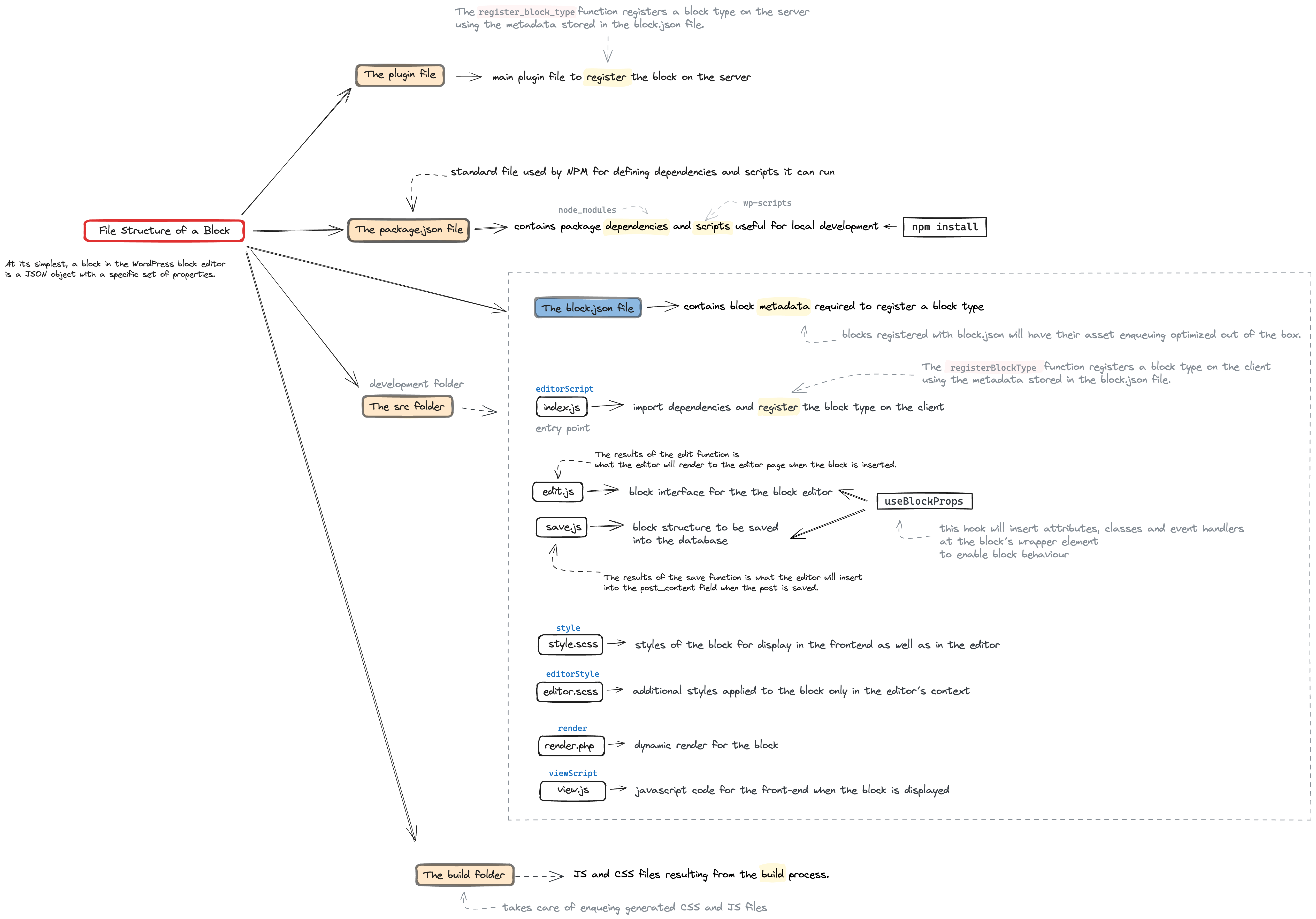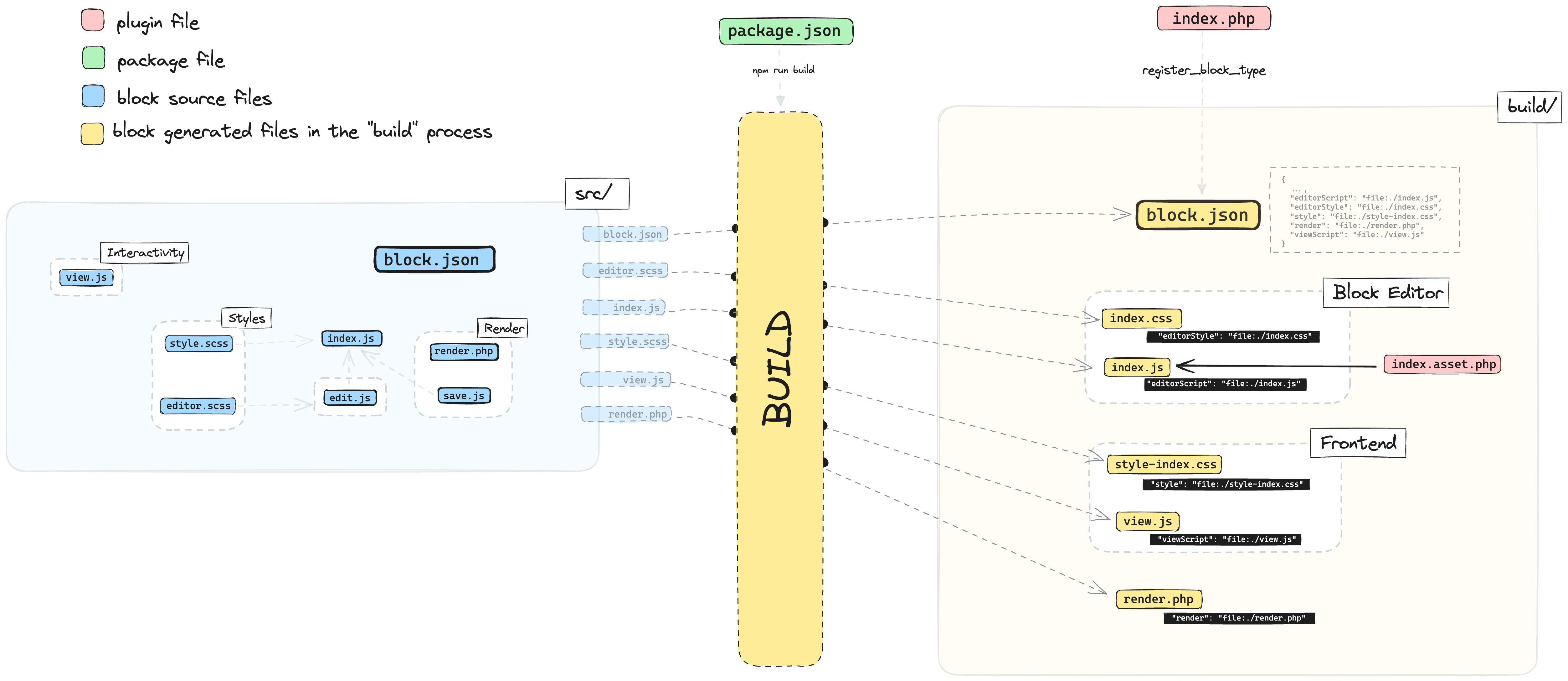When developing custom blocks for WordPress, it’s best practice to register them within plugins rather than themes. This strategy guarantees that your blocks stay accessible, even when users switch themes. While there might be situations where embedding blocks directly into a theme could be appropriate, this guide focuses on blocks housed within a plugin. Specifically, it details the file structure as produced by the create-block tool.
Adhering to the create-block tool’s structure is not mandatory, but it serves as a reliable reference. The files it generates encompass everything needed for a block’s definition and registration. Following this structure can help maintain consistency and ensure your blocks are well-organized and easy to maintain.
<plugin-file>.php
When creating a block in a WordPress plugin, you usually register the block on the server in the main PHP file of the plugin. This is done using the register_block_type() function.
package.json
The package.json file is used to configure a Node.js project, which is technically what a block plugin is. In this file, you define the npm dependencies of the block and the scripts used for local development.
src folder
In a standard project, the src (source) folder contains the raw, uncompiled code, including JavaScript, CSS, and other assets necessary for developing the block. This is where you write and edit your block’s source code, utilizing modern JavaScript features and JSX for React components.
The build process provided by wp-scripts will then take the files from this folder and generate the production-ready files in the project’s build folder.
block.json
The block.json file contains the block’s metadata, streamlining its definition and registration across client-side and server-side environments.
This file includes the block name, description, attributes, supports, and more, as well as the locations of essential files responsible for the block’s functionality, appearance, and styling.
When a build process is applied, the block.json file and the other generated files are moved to a designated folder, often the build folder. Consequently, the file paths specified within block.json point to these processed, bundled versions of the files.
A few of the most important properties that can be defined in a block.json are:
editorScript: Usually set with the path of a bundledindex.jsfile that was built fromsrc/index.js.style: Usually set with the path of a bundledstyle-index.cssfile that was built fromsrc/style.(css|scss|sass).editorStyle: Usually set with the path of a bundledindex.cssthat was built fromsrc/editor.(css|scss|sass).render: Usually set with the path of a bundledrender.phpthat was copied fromsrc/render.php.viewScript: Usually set with the path of a bundledview.jsthat was built fromsrc/view.js.
index.js
The index.js file (or any other file defined in the editorScript property of block.json) is the entry point file for JavaScript that should only get loaded in the Block Editor. It’s responsible for calling the registerBlockType function to register the block on the client and typically imports the edit.js and save.js files to get the functions required for block registration.
edit.js
The edit.js file contains the React component responsible for rendering the block’s editing user interface, allowing users to interact with and customize the block’s content and settings in the Block Editor. This component gets passed to the edit property of the registerBlockType function in the index.js file.
save.js
The save.js exports the function that returns the static HTML markup that gets saved to the WordPress database. This function gets passed to the save property of the registerBlockType function in the index.js file.
style.(css|scss|sass)
A style file with extensions .css, .scss, or .sass contains the styles of the block that will be loaded in both the Block Editor and on the front end. In the build process, this file is converted into style-index.css, which is usually defined using the style property in block.json
wp-scripts includes a css-loader chained with postcss-loader and sass-loader that allows it to process CSS, SASS or SCSS files. Check Default webpack config for more info
editor.(css|scss|sass)
An editor file with extensions .css, .scss, or .sass contains the additional styles applied to the block in the Block Editor. You will often use this file for styles specific to the block’s user interface. This file is converted to index.css during the build process, usually defined using the editorStyle property in block.json.
render.php
The render.php file (or any other file defined in the render property of block.json) defines the server-side process that returns the markup for the block when there is a request from the front end. If defined, this file will take precedence over other ways to render the block’s markup on the front end.
view.js
The view.js file (or any other file defined in the viewScript property of block.json) will be loaded in the front end when the block is displayed.
build folder
The build folder contains the compiled and optimized versions of the code from the src folder. These files are generated from the build process, triggered by the build or start commands of wp-scripts.
This transformation process includes minification, transpilation from modern JavaScript to a version compatible with a wider range of browsers, and bundling of assets for efficient loading. WordPress ultimately enqueues and uses the build folder’s contents to render the block in the Block Editor and on the front end.
webpack-src-dir and output-path option of wp-scripts build commands to customize the entry and output points.

